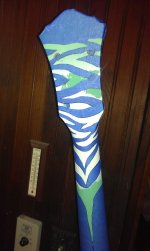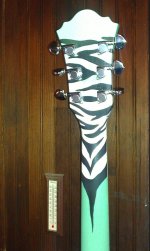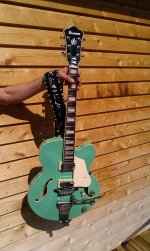Marveltone
Veteran Member
- Joined
- Jun 20, 2010
- Messages
- 1,483
- Location
- Somewhere north of Roseau, MN
- Tractor
- Fordson Major Diesel, McCormick Deering W4, Ford 1510, John Deere L111
I guess this post isn't related to anything else on this site other than this is one of the things I do. I play guitar for my church band. (Hence, my user name. If you can't play well, at least have marvelous tone!) Things can sometimes get a bit animated when you get a bunch of musicians together, no matter what the occasion. This is no different. One day during practice I was working my way across the stage with my acoustic guitar (plugged in) when I felt the cord tug on something. I stopped and started to turn,,, Too late! It had hooked on the stand that was holding my favorite electric guitar and had sent it crashing to the stage. The head stock snapped off! :shocked:There was silence in the room. "I think Joe needs a little quiet time." said another musician. "I can fix that!" I said, and continued the practice.
I took the guitar home, removed the strings and proceeded to glue and clamp it together, using Titebond, knowing it's a high-quality wood glue. The next day I gingerly removed the clamps and restrung the guitar, slowly tightening the strings one at a time and listening for anything that sounded like joint failure. It held! :thumbsup:
This repair job held for a few weeks until my son was playing the guitar and leaned it up against the table to take a short break. The cat decided this was a good time to come brush up against the guitar... CRASH! Headstock detachment number two.
Another glue and clamp job held it in place for another two or three years, until one day at practice, I opened the case and there it was... Snapped off again. By this time I realized there wasn't enough strength left in the wood fibers around the joint to glue it up again.:thumbdown:
By this time I realized there wasn't enough strength left in the wood fibers around the joint to glue it up again.:thumbdown:
This time I called in the experts. I found a luthier in the Twin Cities area who had done many repairs of this sort. His solution was to route a couple grooves in the back of the neck, insert two graphite rods and epoxy them in place. The resulting repair would actually be stronger than the original joint.
The repair itself was straightforward enough, but it left one little conundrum. Due to the rather unique color of my guitar, there was really no way he would be able to match the color, but it had to be repainted at the head stock to seal the wood from moisture, oils and dirt. I told him just to paint it white and I'd do the rest.
I knew there would be no way to do a decent paint match so I decided to do something radical. Instead of hiding the repaired area, I'll make it a feature! I already had a fun guitar strap with faux zebra fur on it, so why not pick up on the theme?
I picked up a little painter's tape and some rattle cans of paint and clear coat and went to work. Here's the end result.
Joe
I took the guitar home, removed the strings and proceeded to glue and clamp it together, using Titebond, knowing it's a high-quality wood glue. The next day I gingerly removed the clamps and restrung the guitar, slowly tightening the strings one at a time and listening for anything that sounded like joint failure. It held! :thumbsup:
This repair job held for a few weeks until my son was playing the guitar and leaned it up against the table to take a short break. The cat decided this was a good time to come brush up against the guitar... CRASH! Headstock detachment number two.
Another glue and clamp job held it in place for another two or three years, until one day at practice, I opened the case and there it was... Snapped off again.
This time I called in the experts. I found a luthier in the Twin Cities area who had done many repairs of this sort. His solution was to route a couple grooves in the back of the neck, insert two graphite rods and epoxy them in place. The resulting repair would actually be stronger than the original joint.
The repair itself was straightforward enough, but it left one little conundrum. Due to the rather unique color of my guitar, there was really no way he would be able to match the color, but it had to be repainted at the head stock to seal the wood from moisture, oils and dirt. I told him just to paint it white and I'd do the rest.
I knew there would be no way to do a decent paint match so I decided to do something radical. Instead of hiding the repaired area, I'll make it a feature! I already had a fun guitar strap with faux zebra fur on it, so why not pick up on the theme?
I picked up a little painter's tape and some rattle cans of paint and clear coat and went to work. Here's the end result.
Joe
Attachments
-
 375260_2485833753426_1480118555_32587212_949303537_n.jpg146.2 KB · Views: 144
375260_2485833753426_1480118555_32587212_949303537_n.jpg146.2 KB · Views: 144 -
 524128_3160575661552_1480118555_32863444_1705006396_n.jpg76.7 KB · Views: 128
524128_3160575661552_1480118555_32863444_1705006396_n.jpg76.7 KB · Views: 128 -
 563387_3160573221491_1480118555_32863442_489664447_n.jpg130 KB · Views: 150
563387_3160573221491_1480118555_32863442_489664447_n.jpg130 KB · Views: 150 -
 530267_3161139595650_1480118555_32863660_54355134_n.jpg146.7 KB · Views: 172
530267_3161139595650_1480118555_32863660_54355134_n.jpg146.7 KB · Views: 172
